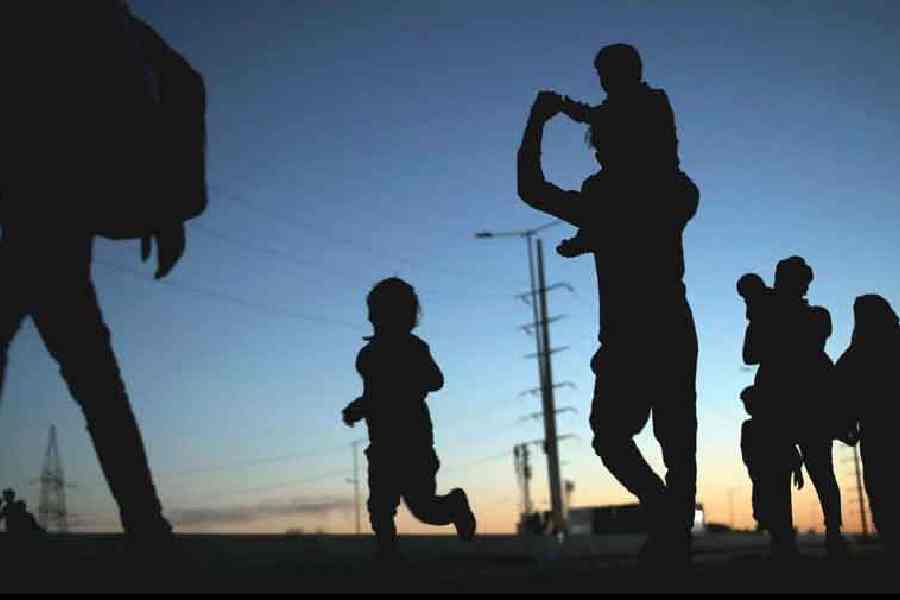At a remote spot in the Arizona desert, near a hole in the border wall, dozens of migrants huddled over wood fires.
After fleeing war in Sudan, violent gangs in Central America or Mexican cartels, the men had all crossed into the US illegally, walked on foot over rugged terrain for hours and arrived at this outpost exhausted, hungry and cold.
They wanted to turn themselves into authorities to ask for asylum but were stranded here, miles from the closest town, Sásabe.
Then, as temperatures dropped on Tuesday night, a convoy of Border Patrol agents rolled in, loaded the men into a van to be processed and sped away — off to search for more people in need of rescue.
“We are not equipped to deal with this,” Scott Carmon, a Border Patrol watch commander, said while surveying the muddy encampment. “It’s a humanitarian disaster.”
This is the crisis unfolding at the southern border, as migrant encounters once again hit record levels and test the capacity of American law enforcement to contain an explosion of illegal crossings with far-reaching repercussions for the Biden administration.
Thousands of migrants are arriving at the border every day, trekking from the farthest reaches of the globe, from Africa to Asia to South America, driven by relentless violence, desperation and poverty.
In May, the Biden administration briefly celebrated when crossings declined, even after pandemic-era border restrictions were lifted and many feared the floodgates would open. But the numbers have spiked in recent months, provoking sharp criticism from both parties and fears within the administration that the issue will damage Democrats’ electoral future.
Last week, the number of apprehensions reached more than 10,000 a day — stretching the resources of the Border Patrol and overwhelming small towns on both sides of the border, where people have been funneled by smugglers consolidating new routes to evade capture by U.S. authorities.
“In terms of migrants per day, December 2023 is bigger than any average we have ever seen,” said Adam Isacson, a migration expert at the Washington Office on Latin America. “Every official who is commenting on it, on all levels, says they’re near or past the breaking point.”
Secretary of state Antony Blinken and other senior officials travelled to Mexico on Wednesday to discuss the spike in migration with President Andrés Manuel López Obrador, while US officials monitored a new caravan of more than 2,000 migrants moving north through the country towards the US.
The caravan is unlikely to make it to the US, experts said, but it has drawn significant media attention to the tide of migrants who have already crossed the border en masse.
Mexico has been a stalwart enforcer of US border restrictions, detaining a record number of migrants this year, government figures show. But in December, the National Migration Institute, a government agency, suspended migrant deportations from the country because of a lack of funding, according to an institute official who was not authorized to speak publicly.
Experts and officials are still piecing together exactly what’s behind the recent migration swell.
Among the theories: larger numbers of Mexicans who seem to be fleeing cartel turf battles across the country, rumours about the end of a key legal pathway that may have prompted a rush to cross and smugglers who have pushed desperate people to try to enter at increasingly remote parts of the border.
“If you move to a place that’s super remote, there won’t be a lot of agents on staff, and that increases your chances of being released into the US,” Isacson said. “There is nowhere to put people. They can’t hold you.”
Izzeddin, a 32-year-old migrant from Sudan, was among about a dozen men from his homeland at the Arizona encampment on Tuesday.
He sipped sugary coffee provided by an aid group, No More Deaths, that has helped keep migrants alive with
blankets, food and 911 calls to address life-threatening injuries.
“We came here because we need protection,” said Izzeddin, who asked to be identified by only his first name, fearing reprisals against his family.
A raging civil war in Sudan has driven millions from their homes, including these men.
New York Times News Service











